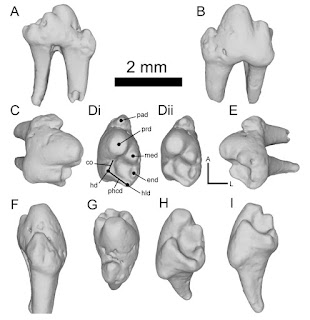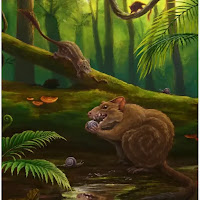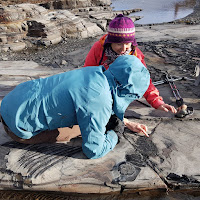[Most Recent Entries] [Calendar View]
Wednesday, April 9th, 2025
| Time | Event | ||
| 3:45a | [Paleontology • 2025] Helmetia expansa Walcott, 1918 Revisited – New insights into the internal anatomy, moulting and phylogeny of Conciliterga
Abstract The trilobitomorphs are a megadiverse and ecologically versatile group of Paleozoic euarthropods that include the iconic trilobites, as well as non-biomineralized clades exclusively known from Konservat-Lagersttätten. The concilitergans, defined by the presence of a broad, variably effaced and flattened dorsal exoskeleton, have received comparatively little attention. This is particularly true for Helmetia expansa from the mid-Cambrian Burgess Shale (British Columbia) – the first chronologically reported species of Conciliterga, which was originally figured (based on a single specimen) by Walcott (1918). Here, we present the first comprehensive description of H. expansa based on all material available from the Burgess Shale, totalling 36 specimens housed at the Royal Ontario Museum and the Smithsonian Institution. The non-biomineralized dorsal exoskeleton is broad and flat, with a serrated margin throughout. The body consists of a cephalon with well-developed anterolateral spines, six thoracic tergites and a large pygidium bearing two pairs of lateral spines and a single terminal spine. The preserved appendages include short uniramous antennae followed by 15 pairs of homonomous and biramous limbs composed of a gracile endopodite and an exopodite with a broad lobe and thick lamellae. The digestive system consists of a straight gut tract, including a ‘J’-shaped foregut and five paired digestive glands on the anterior half of the body expressed as small and convex oblong structures with a submillimetric lamellar ultrastructure. Two specimens of H. expansa provide the first direct evidence of moulting in concilitergans. The lack of dorsal ecdysial sutures suggests a marginal moulting strategy similar to extant Xiphosura. A revised phylogeny of Trilobitomorpha supports Arthroaspis bergstroemi from the early Cambrian Sirius Passet of Greenland as the earliest branching concilitergan and prompts a new diagnosis for the clade. Our results inform the internal relationships within Conciliterga and formalize the families Helmetiidae (Helmetia, Rhombicalvaria, Haifengella and Kuamaia) and Tegopeltidae (Tegopelte, Skioldia, Saperion). Keywords: Burgess Shale, Cambrian, Conciliterga, exceptional preservation, Helmetiida, moulting Artiopoda Hou & Bergström, 1997 Trilobitomorpha Størmer, 1944 Conciliterga Hou & Bergström, 1997 Constituent taxa: Arthroaspis bergstroemi Stein et al., 2013; Helmetiida Novozhilov, 1960. Order Helmetiida Novozhilov, 1960 Constituent taxa: Family Tegopeltidae Simonetta & Delle Cave, 1975; Family Helmetiidae Simonetta & Delle Cave, 1975. Family Tegopeltidae Simonetta & Delle Cave, 1975 Constituent genera: Tegopelte Simonetta & Delle Cave, 1975; Skioldia Hou & Bergström, 1997; and Saperion Hou & Bergström, 1997. ... Family Helmetiidae Simonetta & Delle Cave, 1975 Emended diagnosis: Concilitergans in which the thorax has tergites with non-effaced boundaries and well-developed pleural spines, and a pygidium with variable number of posterolateral spines and a medial terminal spine with a broad base. Constituent genera: Helmetia Walcott, 1918; Rhombicalvaria Hou, 1987; Haifengella Zhao et al., 2014; Kuamaia Hou & Bergström, 1997. Genus Helmetia Walcott, 1918 Type species: Helmetia expansa Walcott, 1918 Conclusion: We redescribe Helmetia expansa as one of the best-known concilitergans based on 36 specimens from the Burgess Shale. It has large anterolateral spines, a serrated margin, a six-segmented thorax and a large pygidium with two pairs of spines. New material reveals insights into the preservation of non-biomineralized structures in H. expansa, including antennae, biramous appendages, optic structures and traces of digestive glands. Additionally, H. expansa acquired an adult exoskeletal morphology that at least doubled in size throughout ontogeny and provides rare direct evidence of moulting in a non-biomineralized Cambrian trilobitomorph. New morphological characters and broader taxon sampling of Cambrian artiopodans clarifies the internal relationships within Conciliterga, which contains Arthroaspis bergstroemi from Sirius Passet and two major families Helmetiidae and Tegopeltidae, both represented in the Burgess Shale and Chengjiang Lagerstätten. Sarah R. Losso, Jean-Bernard Caron and Javier Ortega-Hernández. 2025. Helmetia expansa Walcott, 1918 Revisited – New insights into the internal anatomy, moulting and phylogeny of Conciliterga. Journal of Systematic Palaeontology. 23(1); 2468195. DOI: doi.org/10.1080/14772019.2025.2468195 [04 Apr 2025] | ||
| 7:49a | [Botany • 2025] Lagerstroemia yangchunensis (Lythraceae) • A New Species from Guangdong, China
Abstract A new species from southern China, Lagerstroemia yangchunensis B.H.Wu & G.D.Chen, sp. nov., is described in the present paper. This species is morphologically similar to L. duperreana Pierre ex Gagnep., but can be distinguished by its coarse bark with vertical fissures, calyx lobes glabrous inside, and flowers with shorter pseudopedicels and petals with longer claws. Detailed morphological characteristics, habitat information, and comparisons with similar species are provided. Key words: Crape myrtle, Flora, new species, Yangchun Lagerstroemia yangchunensis B.H.Wu & G.D.Chen, sp. nov. Diagnosis. Lagerstroemia yangchunensis is morphologically similar to L. duperreana, but distinguished by its coarse bark with vertical fissures, calyx lobes glabrous inside, and flowers with shorter pseudopedicels and petals with longer claws. Bao-Huan Wu, Xiu-Ting Liu, Zi-Yu Bao, Xiao-Yan Ma, Ying Chen, Guo-Di Chen, Xing Hu, Guo-Feng Liu and Se-Ping Dai. 2025. Lagerstroemia yangchunensis (Lythraceae), A New Species from Guangdong, China. PhytoKeys. 255: 35-40. DOI: doi.org/10.3897/phytokeys.255.138826 | ||
| 11:11a | [PaleoMammalogy • 2025] Ravjaa ishiii • New Late Cretaceous zhelestid mammal (Eutheria: Zhelestidae) from the Bayanshiree Formation, Mongolia
Numerous exquisitely preserved mammal fossils unearthed from Upper Cretaceous strata in the Gobi Desert of Mongolia have played a key role in understanding Mesozoic mammalian evolution. These splendid mammal fossils have been recovered mainly from the Baruungoyot and Djadokhta formations, but only two fragmentary remains of mammals have been collected from the underlying Bayanshiree Formation. Here we report a new species of Zhelestidae, Ravjaa ishiii gen. et sp. nov., based on a new mammal specimen recently discovered from the Bayanshiree Formation at the Bayan Shiree locality. The new specimen is represented by a well-preserved partial right dentary with the distal portion of an ultimate premolar and the first to the third molars. The gross observation and the phylogenetic analyses demonstrate zhelestid affinities: the subequally tall protoconid and metaconid, closely approximated hypoconulid and entoconid. Zhelestidae was widely distributed from Eurasia to North America in the Late Cretaceous but has not previously been recovered in the abundant Late Cretaceous mammalian fauna of Mongolia. This species represents the first zhelestid from the Mongolian Upper Cretaceous strata and contributes to further understanding of their paleobiogeographic and ecological insights. Key words: Mammalia, Eutheria, Cretaceous, Bayanshiree Formation, Mongolia. Mammalia Linnaeus, 1758 Theria Parker and Haswell, 1897 Eutheria Gill, 1872 Zhelestidae Nessov, 1985a Genus Ravjaa nov. Etymology: Derived from the 5th Noyon Khutugt lama of the Gobi,
Dulduityn Danzanravjaa, the famous Buddhist scholar who was deeply
respected by people in the Dornogobi region, where this specimen was
unearthed. Given that the genus name “Ravjaa” originates from the
personal name of a male figure, it should be considered masculine. Ravjaa ishiii sp. nov. Etymology: In honor of Ken-ichi Ishii, the director of Hayashibara
Museum of Natural Sciences, Okayama, Japan, for his leading role
in the Japanese team of the Mongolia-Japan joint expedition, which
tremendously contributes to Mongolian paleontology.
Holotype: MPC-M 100s/001, partial right dentary with a distal portion
of the ultimate premolar, damaged m1, and well-preserved m2–3. Type locality: Bayan Shiree, located approximately 25 km southwest of
Dzüünbayan, Dornogovi, Mongolia. Type horizon: Cenomanian–Santonian, Upper Cretaceous, Bayanshiree
Formation. Diagnosis.—A zhelestid eutherian that differs from all
other zhelestids in: the faint coronoid crest of the dentary
with the shallow masseteric fossa, the concave dorsal alveolar margin of the dentary, the complete absence of the
labial mandibular foramen, and the significantly high m2
crown that reaches approximately 70% of the height of the
horizontal ramus directly below it on labial view. Tsukasa Okoshi, Ryuji Takasaki, Kentaro Chiba, Masahito Natori, Mototaka Saneyoshi, Akio Takahashi, Shota Kodaira, Shoji Hayashi, Shinobu Ishigaki, Buuvei Mainbayar, and Khishigjav Tsogtbaatar. 2025. New Late Cretaceous zhelestid mammal from the Bayanshiree Formation, Mongolia. Acta Palaeontologica Polonica. 70 (1); 193-203. DOI: doi.org/10.4202/app.01213.2024 | ||
| 2:46p | [PaleoMammalogy • 2025] Weirdodectes napoleoni & Malleodectes arenai • A New Genus and Two New Species of malleodectid (Marsupialia: Malleodectidae) from the Middle and Late Miocene Deposits of the Riversleigh World Heritage Area, northwestern Queensland
Abstract Isolated upper teeth of a new fourth species of Malleodectes, M. arenai sp. nov. and an isolated lower molar representing a new genus of diminutive malleodectid, Weirdodectes napoleoni sp. nov. are described from Riversleigh’s Middle Miocene deposits. In addition, new malleodectid dental material from Middle and Late Miocene deposits at Riversleigh includes the first lower dentition of Malleodectes mirabilis and the first upper dentition of M. wentworthi. Comparisons of the upper and lower dentitions of M. mirabilis and M. wentworthi with that of the putative dasyurid Barinya wangala suggests that taxon is also a malleodectid. Parsimony and Bayesian phylogenetic analyses support a congeneric relationship between M. mirabilis and M. wentworthi, and support assignment of species of Barinya to Malleodectidae. These analyses support previous studies that found malleodectids were more closely related to dasyurids and myrmecobiids than to thylacinids. The snail-eating hypothesis for malleodectids is restricted to species of Malleodectes, with a more generalised durophagous diet suggested for B. wangala. The diet of Weirdodectes napoleoni sp. nov. is unknown but its dentition suggests it was highly specialised. Keywords: Dasyuromorphia, Malleodectidae, Riversleigh, Taxonomy, Phylogenetics MAMMALIA Linnaeus, 1758 MARSUPIALIA Illiger, 1811 sensu Beck et al. (2014) DASYUROMORPHIA Gill, 1872 sensu Kealy and Beck (2017) †MALLEODECTIDAE Archer et al., 2016 Type species: Malleodectes mirabilis Arena et al., 2011. †Malleodectes arenai sp. nov. Etymology: The species name arenai honours Dr Rick Arena for his contributions to palaeontological and geological research at Riversleigh including description of the genus Malleodectes.
?MALLEODECTIDAE Archer et al., 2016 Subfamily incertae sedis †WEIRDODECTES gen. nov. Etymology: The genus name, Weirdodectes, describes the bizarre and highly specialised m1 crown morphology of this taxon which is unlike any other marsupial carnivore currently known. †Weirdodectes napoleoni sp. nov. Etymology: The species name, napoleoni, honours the late Napoleon, the Great Pyrenees Mountain dog who provided unwavering emotional support throughout my undergraduate, honours and PhD years. You will be missed my loyal and magnificent friend, but never forgotten. Timothy J. Churchill, Michael Archer and Suzanne J. Hand. 2025. A New Genus and Two New Species of malleodectid (Marsupialia, Malleodectidae) from the Middle and Late Miocene Deposits of the Riversleigh World Heritage Area, northwestern Queensland. Journal of Mammalian Evolution. 32, 16. DOI: doi.org/10.1007/s10914-025-09755-6 | ||
| 7:28p | [Paleontology • 2025] The First gravid ichthyosaur from the Hauterivian (Early Cretaceous): a complete Myobradypterygius hauthali von Huene, 1927 excavated from the border of the Tyndall Glacier, Torres del Paine National Park, southernmost Chile
ABSTRACT Ichthyosaurs were pelagic marine reptiles with a global distribution through most of the Mesozoic. Cretaceous Ichthyosauria are mostly known from the northern hemisphere, although findings from the southern hemisphere have been reported from Australia, Argentina, Chile, and New Zealand. Despite these findings that have contributed to knowledge of the clade, there is still a dearth of information about the evolution, phylogenetics, and ecology of Cretaceous ichthyosaurs from the Southernmost Pacific margin of Gondwana. A Lower Cretaceous locality next to the Tyndall Glacier, inside Torres del Paine National Park, southernmost Chile, has yielded 87 ichthyosaur skeletons to date. Most of the specimens recorded from this area are complete and articulated, however, they are affected by recent weathering and the constant erosion. Here we describe a complete platypterygiine ichthyosaur, which we provisionally assign to Myobradypterygius hauthali von Huene, 1927. The specimen was excavated from the border of the glacier in Patagonia during March and April 2022 and corresponds to the first complete excavated ichthyosaur from Chile. This specimen additionally preserves gastrointestinal contents and is the only Hauterivian (131 Ma) ichthyosaur documented to date containing the articulated skeleton of a preserved fetus. This research increases the knowledge of the paleobiology of the species. In addition to morphology, it contributes information regarding paleoecology and paleopathology, diet, and reproduction in M. hauthali, a taxon potentially restricted to the Pacific margin of Gondwana. Judith M. Pardo-Pérez, Matthew Malkowski, Patricio Zambrano, Dean R. Lomax, Cristina Gascó Martín, Jonatan Kaluza, Héctor Ortíz, Andrés Pérez Marín, Rodrigo Villa-Martínez, Marko Yurac, Miguel Cáceres, Aymara Zegers, Javiera Delgado, Francisca Scapini, Catalina Astete and Erin E. Maxwell. 2025. The First gravid ichthyosaur from the Hauterivian (Early Cretaceous): a complete Myobradypterygius hauthali von Huene, 1927 excavated from the border of the Tyndall Glacier, Torres del Paine National Park, southernmost Chile. Journal of Vertebrate Paleontology. e2445705. DOI: doi.org/10.1080/02724634.2024.2445705 [25 Feb 2025] facebook.com/JonatanKaluza/posts/10161610354016200 |
| << Previous Day |
2025/04/09 [Calendar] |
Next Day >> |


























